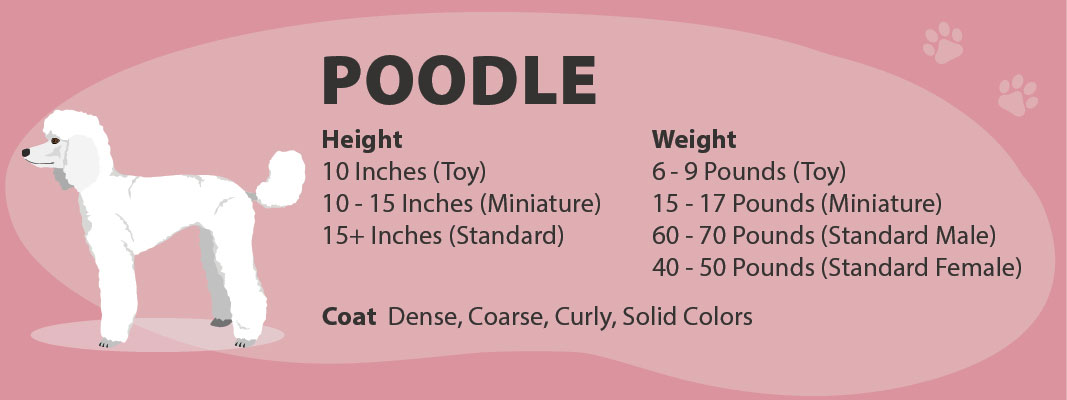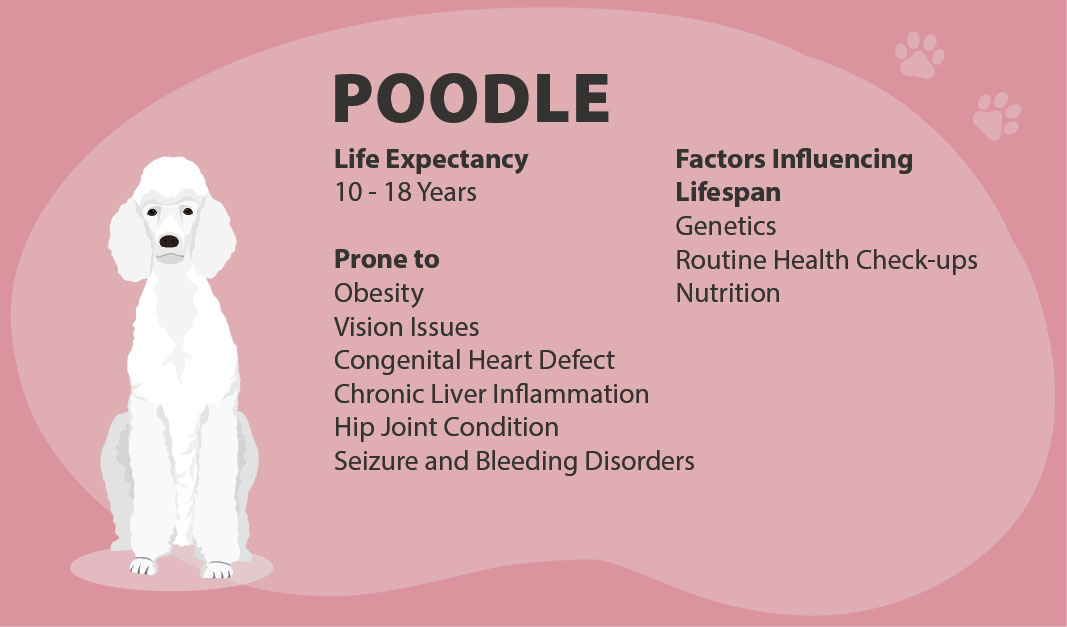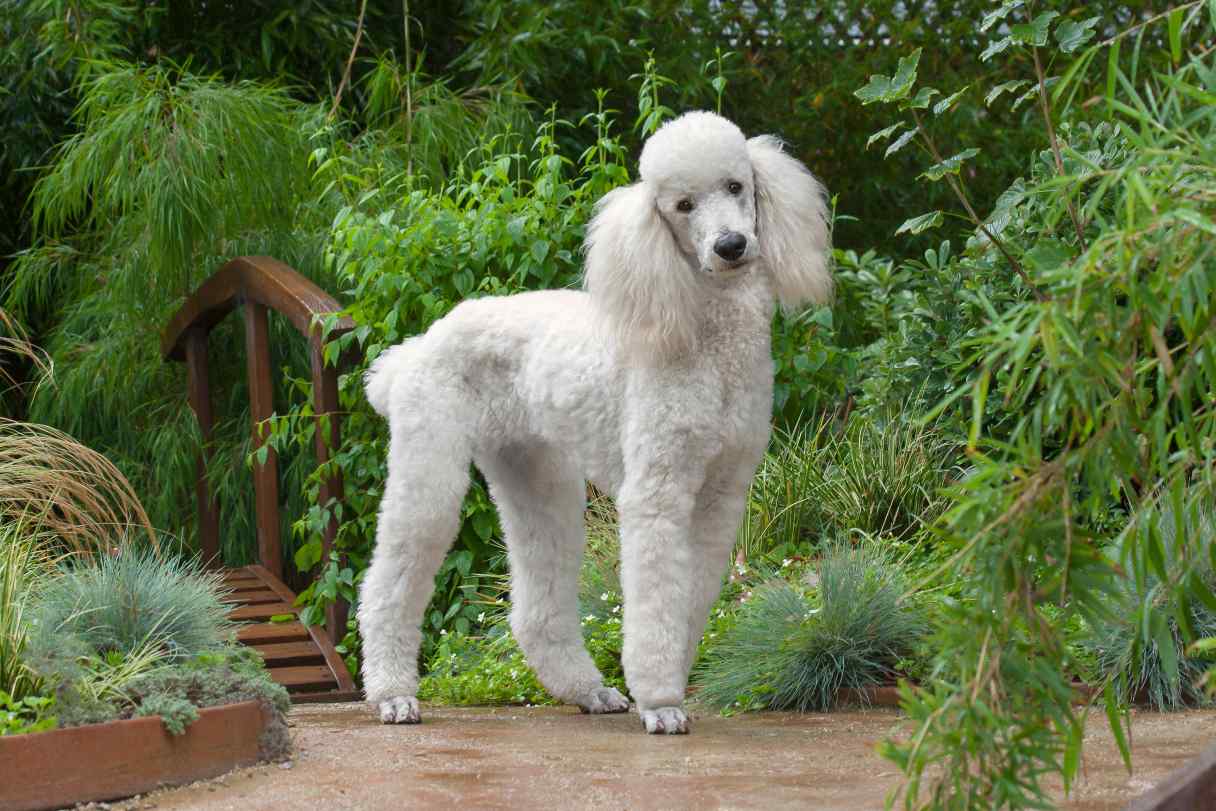Poodles come in three sizes, but whether a large standard, a small miniature or a tiny toy, they’re all poodle, through and through. These exceptionally bright, athletic and quirky dogs will go out of their way to delight their owners.1
Are you a good match for one of these entertaining fluffballs? Learn more about poodle temperament, health needs and daily care so you’ll know if they’re a good fit for your home and lifestyle.
About the Poodle
Although this breed is so adored in France that it’s their national dog, the “French” poodle doesn’t have a single French bone in its body. More than four centuries ago in Germany, the original standard poodle was bred to dive into water and retrieve ducks. The breed’s name comes from the German word pudelin, which means to splash around in water. Incidentally, in France, these dogs are called Caniche, which translates to “duck dog.”1
Even now, both standard and miniature poodles are used by hunters as retrievers. Their distinctive haircut may look frou-frou, but it serves the practical purpose of providing mobility in water while protecting sensitive parts from the cold. But despite their down-to-earth origins, this breed’s elegant looks made it popular with European nobility, and their eagerness to entertain people led to them becoming circus performers.1
The tiny toy poodle was added to the line by American breeders in the early 20th century. Although toys were bred to be companion dogs for city dwellers, they possess the same charm, intelligence and athleticism as their larger siblings.1
Poodle Appearance

Poodles are grouped into three sizes. Toys can get up to 10 inches1 at the shoulder and weigh six to nine pounds.2 Miniatures stand between 10 and 15 inches1 and weigh 15 to 17 pounds.2 Standard poodles are over 15 inches tall, although most range from 22 to 27 inches.3 With standard poodles, males may weigh more than females, typically 60 to 70 pounds, whereas females weigh between 40 and 50 pounds.1
Size is where the differences end. Otherwise, all poodles are squarely built, with long necks that allow the head to be held high, giving them a dignified appearance.4 They have a deep chest and a straight back, with a straight tail that is typically docked to keep it from being out of balance with the body.4 However, the American Veterinary Medical Association (AVMA) discourages tail docking for cosmetic purposes and encourages breed clubs to remove this practice from their breed standards.5
The poodle’s coat is its most telling feature. Made of dense, coarse, curly hair that keeps growing all over the body, there are several ways it can be styled and worn. But most pet poodle owners who aren’t entering their pups in the show ring opt for a low-maintenance puppy or sporting clip, in which the face, throat, feet and base of the tail are shaved close. The remaining hair is kept about an inch long. Poodles usually come in solid colors, including white, gray, brown, cream, apricot and black.4
Poodle Temperament
The American Kennel Club (AKC) describes poodles as “eager, athletic and wickedly smart dogs of remarkable versatility.”1 They have a sense of pride evident in the graceful and dignified way they carry themselves.4 As the Poodle Club of America puts it, “A poodle is a ‘person’ and he expects to be treated as one.”3
Poodles are active, energetic dogs who love to engage in activities and adventures with their people. This is an intelligent breed that enjoys training as long as it’s fun, positive and consistent. Poodles learn quickly and love to perform for human attention.1
If you want an affectionate love bug, look no further. Poodles thrive on giving and receiving love, and they’re quick to make new friends. But they’re also protective of their family and will be sure to bark at any perceived threats. So, while they’re too friendly for guard dogs, they do make excellent watchdogs, regardless of their size.1
Poodles get along great with kids and do well with other pets, making them an excellent choice for a family dog.1 That said, due to their size and fragility, toy poodles should be supervised around small children, who should be taught how to be gentle with these tiny pups.
Living With a Poodle
Poodles are highly versatile and adaptable dogs. But does that mean they’re right for everyone? Here’s what it’s like to live with and care for a poodle, along with helpful tips for both current and prospective poodle parents.
Who they’re best for
Poodles need a home in which they’re treated like a member of the family. These dogs love to be with people, so they’re not the best breed to be left home alone all day while everyone goes off to work or school. They’re also not the type of dog you can turn outdoors and expect to entertain themselves.3
While standard poodles are best suited for someone with the energy to provide them with an active and athletic lifestyle, miniatures and toys, though still energetic, don’t need as much physical exercise as their larger siblings and would be a better fit for less active people. That said, these super-smart little dogs still need someone to engage with them and provide plenty of mental stimulation.1
Living space
While toys and miniatures are as well suited to apartment living as standards are to country life, each individual dog is highly adaptable and can thrive in almost any setting. Even large standard poodles can do well in apartments as long as they get taken outside regularly for exercise and play.2
Regardless of where you live, prospective poodle owners should be prepared to keep their pooch on a leash if a fenced-in yard isn’t available. The poodle’s hunting instincts make it too much of a flight risk if allowed to roam off leash — and for the tiny variety especially, this could be deadly.3
Exercise and activity
Poodles are active, playful and energetic. Standards bred for hunting will love to accompany nonhunting human companions on hikes, jogs or long walks, while owners of their shorter-legged siblings can satisfy retriever instincts with games of fetch. Poodles of all sizes are also water dogs who love to swim.1
These dogs need mental activity as much as they need physical activity. They love learning new tricks and going on adventures. Even the tiny variety is a great match for someone who loves to travel or go camping with their pooch.1
Grooming
Poodles barely shed, but their hair keeps growing and needs to be trimmed and brushed regularly. You may opt to take your poodle to a professional groomer once a month, although the sporting clip is fairly easy for poodle parents to do at home.1
How much brushing poodles need depends on the length of their hair. The longer the coat, the more brushing they’ll need to prevent matting.1 Monthly baths with a detangling conditioner can also help keep the coat manageable. Some poodles are prone to skin issues. A good moisturizing shampoo or an oatmeal bath can help soothe inflamed or itchy skin.6
Nails should be trimmed at least as often as a poodle's coat.1 Also, brushing their teeth a few times a week or more will help their teeth and gums stay healthy between veterinary dental cleanings.
Poodle Health and Life Expectancy

The average poodle lifespan ranges from 10 to 18 years.1 Small dogs tend to live longer than large dogs as a general rule, so standard poodles are more likely to be on the shorter end of their breed's range.7 But each dog is different, and factors like genetics, routine health checkups and nutrition all impact how long an individual dog lives.
You’ll need to feed your poodle high-quality dog food with a nutritional profile approved by the Association of American Feed Control Officials (AAFCO). To ensure maximum nutrition, choose a food that’s formulated for your dog’s size and current life stage.1
Some poodles may be prone to obesity, so you should measure food according to package instructions to avoid overfeeding. If you’re not certain about the right amount for your dog’s size, talk to your vet. Be sure to factor treats — including those used for training — into their daily calorie allotment and avoid giving them table scraps.1 You can also replace high-calorie commercial dog treats with healthier foods that are safe for dogs.
Poodles face several breed-specific health issues that even the best health care may be unable to prevent. If you’re shopping for a poodle puppy, look for an ethical breeder who does genetic testing to screen out hereditary health issues as much as possible. Even then, some health issues may still slip through.
Both current and prospective poodle parents should know about these potential health issues:8
Addison’s disease
Also known as hypoadrenocorticism, Addison’s disease is an adrenal hormone deficiency that primarily affects standard poodles.9 It may be caused by autoimmunity, pituitary cancer, the sudden withdrawal of corticosteroids or other unknown factors.8 Signs include vomiting and other gastrointestinal (GI) issues, lethargy and decreased appetite.8 This is a serious illness that, if untreated, can result in heart arrhythmia or even cardiac arrest.8
Treatment usually involves addressing the symptoms — which may be critical — to stabilize the dog, followed by hormone replacement therapy to address hormone deficiencies. There is no cure, and dogs diagnosed with this disease will need monthly vet visits and hormone shots for the rest of their lives.9
Atrial septal defects (ASD)
ASD is a congenital heart defect that causes puppies to be born with a hole between the upper chambers of the heart. Depending on the size of the hole, ASD may cause symptoms such as coughing, breathing difficulty, exercise intolerance, fainting, collapse or even sudden death. It can usually be repaired via surgery.8
Chronic active hepatitis
With chronic active hepatitis, liver inflammation and necrotic liver tissue result in progressive liver failure. Symptoms usually appear in middle-aged dogs between 5 and 7 years of age and include vomiting and diarrhea, appetite loss, weight loss, depression and increased thirst. In advanced cases, the whites of the eyes may take on a yellowish tint. There is no cure, but if caught early this disease may be managed for quite some time through medication and dietary changes.8
Cushing’s disease
The opposite of Addison's disease, Cushing’s disease causes the adrenal glands to produce too much cortisol. It is typically seen in senior dogs, although it can affect younger dogs as well.8
There are three types, the most common of which occurs when a slow-growing tumor on the pituitary gland triggers an overproduction of cortisol by the adrenals. A second type of Cushing’s is caused by a tumor directly on the adrenal glands, which is often malignant. The third type can result from long-term use of corticosteroid drugs.8
Symptoms include excessive appetite and thirst, frequent urination, thinning hair and hair loss, dull hair texture, thin skin and an extended belly.8 Treatment depends on the type of Cushing’s disease. Surgery may be possible for adrenal tumors; otherwise, medication and regular vet visits for close monitoring will be required.10
Epilepsy
Epilepsy is a seizure disorder caused by abnormal brain function. In poodles, the most common form of epilepsy is idiopathic, meaning that the cause is unknown. Seizures may be general, causing the entire body to go rigid as the dog loses awareness. Focal seizures are less severe and result in behavioral tics such as head shaking or circling. Most epileptic dogs can live long and happy lives while their seizures are managed with medication.8
Legg-Calve-Perthes (LCPD)
LCPD is a genetic disorder in small poodles in which the blood flow to the femoral artery in the hip joint gets cut off, resulting in the death of bone tissue. This can produce lameness in one or both of the hind legs. It’s typically treated via surgical removal of the affected part of the hip bone. In small dogs, hip replacement usually isn’t needed, and dogs typically recover full mobility. In the rare cases that it affects larger dogs, hip replacement surgery may be needed.11
Vision issues
Poodles are prone to developing cataracts, including juvenile cataracts at a young age. But they’re also at risk of progressive retinal atrophy, a disease affecting the retina that causes progressive blindness, as well as optic nerve hypoplasia, a congenital optic nerve abnormality that also causes blindness.8
Von Willebrand’s disease (VWD)
Von Willebrand's disease is a heritable bleeding disorder. It’s caused by a protein deficiency that prevents blood platelets from sticking together and forming clots, which results in prolonged bleeding and may also result in spontaneous hemorrhaging. In severe cases, dogs can bleed to death. Dogs with this disorder should avoid certain antibiotics and other medications that can thin blood even further. Treatment involves blood transfusions to stabilize bleeding. Unfortunately, there is no cure.12
Buying or Adopting a Poodle
Poodle puppies from a reputable breeder vary in price based on size, but you can expect to pay somewhere around the following:13
- Standard poodles: $2,500
- Miniature poodles: $3,500 to $4,000
- Toy poodles: $2,500 to $4,500
Pricing for each depends on location and whether the parents are from championship lines. The cost typically includes early healthcare, vaccinations and genetic testing.13
Poodles and poodle mixes of all sizes and ages are often available through pet shelters and poodle rescue organizations. Adoption fees vary depending on location and the size and age of the poodle, as well as any special needs the dog may have and any veterinary care it has received.14 They’re typically around $500, which usually covers the cost of vaccinations, spaying or neutering and other necessary vet care.15
You can find a list of reputable poodle rescue organizations across the U.S. at the Poodle Club of America Rescue Foundation.
Frequently Asked Questions About Poodles
Here are some common questions people are asking about poodles.
CareCredit Credit Card Financing for Dogs
The CareCredit credit card provides a convenient way to pay for your dog's vaccinations and other health and wellness expenses, including exams, medications and products at providers in the CareCredit network.* Continue your wellness journey by downloading the CareCredit Mobile App. You can find a provider on the go, manage your CareCredit account and easily access the Well U blog for more great articles, podcasts and videos. Use our Acceptance Locator to find a veterinarian that accepts CareCredit to help keep your pet healthy and happy for a lifetime of love.
In addition to pet care, you can also use your CareCredit credit card for dentistry, cosmetic, vision, hearing, health systems, dermatology, pharmacy purchases, spa treatments and so much more within the CareCredit network. How will you invest in your health and wellness next?
Author Bio
Jean Marie Bauhaus is a freelance writer and novelist who has been writing pet content since 2013. Her work has appeared on Forbes.com, Hill's Pet, Chewy, AKC.org and more.














